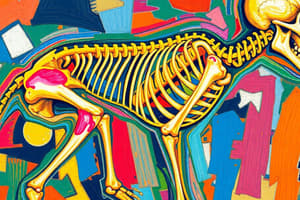Podcast
Questions and Answers
Which type of bone is classified as having a cylindrical shape and is typically longer than it is wide?
Which type of bone is classified as having a cylindrical shape and is typically longer than it is wide?
- Flat bones
- Long bones (correct)
- Short bones
- Irregular bones
What type of joint allows for limited movement, often found in the spine?
What type of joint allows for limited movement, often found in the spine?
- Cartilaginous joints (correct)
- Fibrous joints
- Ball-and-socket joints
- Synovial joints
Which joint type is characterized by no movement and is typically found in structures such as the skull?
Which joint type is characterized by no movement and is typically found in structures such as the skull?
- Hinge joints
- Cartilaginous joints
- Fibrous joints (correct)
- Synovial joints
Sesamoid bones are typically found in locations where there is a lot of friction. Which of the following is an example of a sesamoid bone?
Sesamoid bones are typically found in locations where there is a lot of friction. Which of the following is an example of a sesamoid bone?
What classification of bone is represented by the sternum?
What classification of bone is represented by the sternum?
Which type of bone is specifically found only in the limbs?
Which type of bone is specifically found only in the limbs?
What is the primary characteristic of short bones?
What is the primary characteristic of short bones?
Which of the following bones is an example of an irregular bone?
Which of the following bones is an example of an irregular bone?
What is the function of sesamoid bones?
What is the function of sesamoid bones?
Which of the following is NOT considered a function of the skeleton?
Which of the following is NOT considered a function of the skeleton?
Which joint type allows limited movement and is often found between the vertebrae?
Which joint type allows limited movement and is often found between the vertebrae?
The largest sesamoid bone in the body is known as what?
The largest sesamoid bone in the body is known as what?
Which bone is NOT classified as a flat bone?
Which bone is NOT classified as a flat bone?
Which type of joint is characterized by the absence of a joint cavity and is virtually immovable?
Which type of joint is characterized by the absence of a joint cavity and is virtually immovable?
What type of cartilaginous joint is designed for strength and shock absorbency and is slightly movable?
What type of cartilaginous joint is designed for strength and shock absorbency and is slightly movable?
Which type of synovial joint allows for a wide range of motion and has a complex structure?
Which type of synovial joint allows for a wide range of motion and has a complex structure?
Which of the following joints is an example of a synchondrosis?
Which of the following joints is an example of a synchondrosis?
What type of synovial joint is represented by the hip joint?
What type of synovial joint is represented by the hip joint?
Which of the following joints would be considered immovable?
Which of the following joints would be considered immovable?
Which structure in synovial joints acts as shock absorbers?
Which structure in synovial joints acts as shock absorbers?
What type of joint is the elbow categorized as?
What type of joint is the elbow categorized as?
Flashcards are hidden until you start studying
Study Notes
Bone Development
- Primary ossification occurs before birth, forming the long central shaft of long bones.
- Secondary ossification takes place after birth, resulting in the development of two epiphyses at both ends of long bones.
- Full growth into a single bone structure is typically completed by age 21.
Classification of Bones
- Bones are classified by their shapes:
- Long bones: Found only in limbs, having a body and two enlarged ends (e.g., femur, humerus).
- Short bones: Mainly cancellous bone with a thin outer layer of compact bone (e.g., carpal and tarsal bones).
- Flat bones: Composed of two plates of compact bone with a diploë layer of cancellous bone in between (e.g., sternum, cranium).
- Irregular bones: Uniquely shaped (e.g., vertebrae, pelvic bones).
- Sesamoid bones: Small and oval, developing within and beside tendons, protecting them from wear (e.g., patella).
Specific Functions and Locations of Bones
- Sesamoid bones, like the patella, are located beneath the first metatarsophalangeal articulation and the palmar aspect of the thumb.
- Bone classification aids in understanding the skeletal structure and functions, including muscle attachment, mineral storage, and blood cell production.
Cartilaginous Joints
- Characterized by no joint cavity and are largely immovable.
- Two types of cartilaginous joints:
- Symphysis: Slightly movable, with fibrocartilage pads (e.g., pubic symphysis).
- Synchondrosis: Immovable, united by rigid cartilage (e.g., epiphyseal plate in growing long bones).
Synovial Joints
- Freely movable joints with a wide range of motion, enclosed by an articular capsule.
- Some synovial joints contain accessory structures like menisci (shock absorbers) and bursae (friction reducers).
- Six types of synovial joints:
- Gliding: Intercarpal joints in the wrist.
- Hinge: Elbow joint.
- Pivot: Atlas and axis of cervical spine.
- Ellipsoid: Radiocarpal joint in the wrist.
- Saddle: Carpometacarpal joint.
- Ball and socket: Hip joint.
Review Questions
- Identification of flat bones can include options such as the scapula.
- Functions of the skeleton encompass muscle attachment, mineral storage, and blood cell production; production of minerals is incorrect.
- The location of T7 can be found in relation to landmarks like the jugular notch and inferior angle of the scapula.
Studying That Suits You
Use AI to generate personalized quizzes and flashcards to suit your learning preferences.




